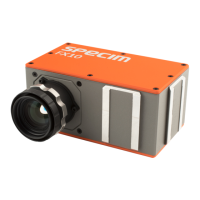| Functionality | 32
Timing parameters
The following table gives an overview of the minimum and maximum values of the trigger and strobe parameters.
Table 5: Timing parameters
Timing parameter Min Max
t
d−iso−input
5 µs (typical) 18 µs
t
jitter
0 50 ns
t
input-jitter
FX10: 75 ns
FX17: 83.3 ns
FX10: 100 ns
FX17: 111.1 ns
t
pulse-delay
0 s 0.466 s
t
trigger−delay
0 s 419 ns
t
trigger−offset
(trigger not during
readout)
600 ns 600 ns
t
exposure-offset
FX10: 225 ns
FX17: 250 ns
FX10: 250 ns
FX17: 280 ns
1)
/ ( time of 1 image
row 6.4 µs)
2)
t
exposure
333 ns 0.466 s
t
timer-delay
0 s 119 s
t
timer-duration
0 s 119 s
t
lineout-offset
111 ns 111 ns
t
d-iso-output
5 µs (typical) 18 µs
t
strobe-delay
0 419 ms
1)
New exposure starts after readout of previous image;
2)
New exposure starts during readout of previous image
Image Correction
Overview
The camera includes the following image corrections:
• Automatic Image Enhancement (AIE)
• Offset and hot pixel correction
All the corrections are enabled by default.
Automatic Image Enhancement (AIE)
Automatic Image Enhancement unifies spectral bands (wavelength calibration) and minimizes keystone and smile. It
functions in camera electronics real time after read-out and non-uniformity correction (fixed pattern removal) steps.
The correction is based on two correction value tables that are generated in final calibration. The correction value
tables are then uploaded to camera's internal memory. Correction values are relative addresses where the camera
output data is interpolated for each pixel. The correction is performed separately in a spectral and a spatial direction.
All rights reserved - Specim, Spectral Imaging Oy Ltd.

